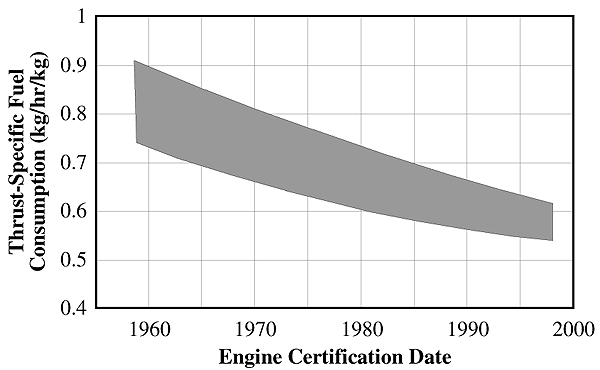7.4.1.1. Thermal Efficiency
One of the most fundamental measures needed to assess the effectiveness of
a gas turbine is its ability to convert the chemical energy of the fuel into
mechanical work-the thermal efficiency of the engine (i.e., htherm = power to
the gas stream/ energy input rate). The precise derivation of this parameter
requires a knowledge of the details of flows within the engine, including air
used inside the engine to cool hot parts. For present purposes, however, a good
estimate of the constraints and potential of the engine can be obtained by neglecting
such minor flows and by further assuming that the working fluid throughout the
engine retains the same properties as air at room temperature throughout the
cycle. The compressor and turbine are inevitably less than perfect, and their
performance is described by efficiencies (hcomp and hturb, respectively). This
simple treatment assumes that hcomp = hturb = 90%; these are plausible "state-of-the-art"
values. The two properties that affect gas turbine thermal efficiency are T4/T2-the
ratio of temperature leaving the combustor (i.e., the turbine inlet temperature)
to that of the air entering the engine-and the overall pressure ratio between
atmospheric pressure and peak pressure within the engine.
Taking first the effects of variations in T4/T2 at typical conditions in the
cruise phase of a modern civil aircraft (Mach 0.85 at 10.7-km altitude), the
inlet temperature, T2, sensed by the engine for standard atmospheric conditions
is 250 K. The upper limit on temperature, T4, would be reached if sufficient
hydrocarbon fuel were burned to consume all the oxygen (stoichiometric combustion;
see Figure 7-8). This temperature would be about
2590 K, though this value depends to some extent on the pressure ratio of the
engine and the efficiency of the components. These values give T4/T2 ª 10.3.
For a mid-1990s engine the value of T4 at cruise is about 1400 K, whereas in
the mid-1970s a value of about 1250 K would have been more typical. For these
combinations of air inlet temperature, and turbine inlet temperature the ratio
T4/T2 would be 5.6 and 5.0, respectively. Figure 7-8
shows, for these three examples, the thermal efficiency of a gas turbine as
a function of pressure ratio for cruise at Mach 0.85 at 10.7 km. The solid lines
are for compressor and turbine efficiencies of 90% and are labeled with the
temperature ratio T4/T2. The broken line is for ideal compressors and turbines
(having hcomp = hturb =100%); in this case, the thermal efficiency is a function
of pressure ratio only.
Figure 7-8 also shows that for high thermal efficiency,
the internal pressure ratio of the engine must be moderately high; for new large
engines, the value is around 40 at peak throttle settings of take-off and climb.
In addition to "internal" compression of air (by the compressor), the aircraft's
forward speed introduces a pressure rise of 1.6 times atmospheric pressure at
Mach 0.85, giving an overall pressure ratio of about 64. Increasing the internal
pressure ratio much beyond this value raises the temperature at compressor exit
to the point where materials are a limitation; furthermore, the higher temperature
increases the problem of cooling the turbine and increases levels of NOx production
in the combustor (as discussed in Section 7.5.2).
Increasing the internal pressure ratio at current values of T4/T2 would offer
very little improvement in thermal efficiency.
|

Figure 7-9: Fuel consumption progress with time.
|
The increase in turbine inlet temperature over the past 20 years has been the
result of research and development, primarily to increase the power-to-weight
ratio of the engine. As Figure 7-8 shows, however,
a modest increase in T4/T2 has had an effect on thermal efficiency. At the theoretical
limit, by operating at stoichiometric fuel-air ratios in the combustion system,
the temperature ratio would be about double that of current engines. The practical
difficulties associated with achieving stoichiometric combustion (largely associated
with maintaining structural integrity with materials that lose strength at high
temperatures), however, remain formidable. Furthermore, even if these difficulties
could be overcome, the thermal efficiency of the engine would still remain below
60% given current levels of turbomachinery component efficiencies. Only when
hcomp = hturb =100% would thermal efficiency approach 70% for an overall pressure
ratio of around 64. Thus, although there are clear gains to be made by further
increases in T4/T2 and thermal efficiency, the full benefits can be achieved
only through parallel efforts aimed at raising propulsive efficiency.
|

Figure 7-10: Overall pressure ratio trend with time.
|
|